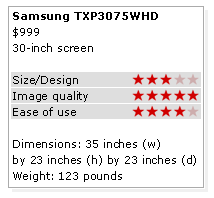NEW YORK (Money Magazine) - Even with the arrival of sexy new flat-panel televisions, there are excellent reasons for sticking to glass-tube TVs -- the kind still built around cathode-ray technology.
What's more, the buzz for flat-panel monitors is pressuring prices of tube TVs, so that this year's models cost less than half of what comparable ones sold for a couple of years ago.
 |
|
| Samsung TXP3075WHD |
These sets look and feel ancient when it comes to size and weight. The 30-inch (measured diagonally, as all TV screens are) Samsung TXP3075WHD is one dense box. But as with many other late-model glass-tube TVs, it is state of the art, delivering the best, brightest and warmest picture on the market.
| Big Screen TVs
|

|
|
|
|
This set rings in at $999 and comes with many easily accessible connections, so you don't have to reach in the back every time you want to plug in a digital photo or video camera. It also comes with an HD tuner -- so you won't need a set-top box to get HD signals -- and its girth allows for superb built-in speakers.
About glass-tube TVs

They come in two shapes, or aspect ratios. Avoid squarish standard models, called 4:3 sets, which are built for traditional television programming. We recommend going with a 16:9 wide-screen set that will showcase DVDs and the growing number of HDTV broadcasts to come.
Also knows as "direct view TVs," wide-screen glass-tube TVs that are HDTV-ready produce the best picture in all of TV Land and have proven technology that is reliable and long lasting. But these sets max out at a screen size of 34 inches (Sony's $2,500 XBR FD).
Wide-screen models can be heavy -- more than 120 pounds on average. Some models require you to heave the TV away from the wall to reach in the back to swap components. Look for those that have front connections for easy access to plug in a digital camera or camcorder.

|

